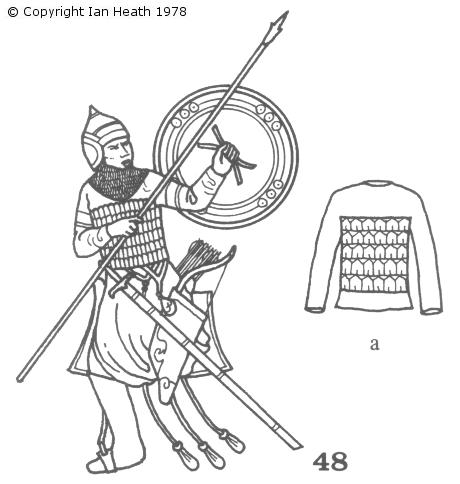SELJUK HEAVY CAVALRYMAN[Based on illustrations in Varqa wa Gulshah]An extract from Armies and Enemies of the Crusades 1096-1291 by Ian Heath  |
SELJUK HEAVY CAVALRYMAN[Based on illustrations in Varqa wa Gulshah]An extract from Armies and Enemies of the Crusades 1096-1291 by Ian Heath  |
48. SELJUK HEAVY CAVALRYMAN
Although the majority of Turkish cavalry seem to have been unarmoured horse-archers, 'heavy' cavalry were also to be found in their armies, these being generally supplied by the retinues and mamluks of the amirs and other chieftains. The chronicler Bar Hebraeus makes much of Alp Arslan, the victor of Manzikert, putting on his armour before the battle, adding that 'all the Turks did likewise'.
This late-12th or early-13th century Seljuk from Azerbaijan wears armour that is of typically Eastern design, comprising a mail hood, Persian-style helmet with neckguard and a waist-length Djawshan that reaches only to the chest.
'Djawshan' seems to have described a lamellar corselet of any length and al-Tartusi says it was of Persian origin. The lamellae were chiefly of iron, horn or treated leather and could be gilded, varnished or painted (Sultan Khai Khosrou I is recorded wearing red armour in 1210), though Seljuk armour was apparently often blackened. That worn here may very well be attached to the tunic itself in the same way as is 48a (with alternate rows of lamellae painted different colours), from a store of arms and armour depicted in an early-13th century source. It is possibly an armour of similar length that is recorded being worn by an Abbasid amir in one of Usamah's anecdotes; describing the Battle of Qinnasrin in 1137 he mentions how a Frankish horseman's lance pierced this amir through the chest and came out at his back, despite his gilded Djawshan.
This man's equipment includes lance, shield, and sword as well as a bow, though Bar Hebraeus states that Alp Arslan cast aside his bow and arrows and fought with spear and shield when he donned his armour. The length of the sword should be noted, such long weapons frequently appearing in Syrian and Persian sources of the 12th and 13th centuries. The helmet could be plumed.
By the late-13th century and probably somewhat earlier most Seljuk heavy cavalry would have closely resembled 58 and 89.